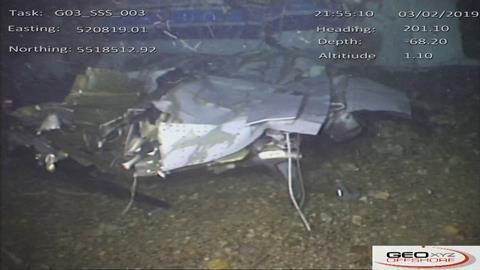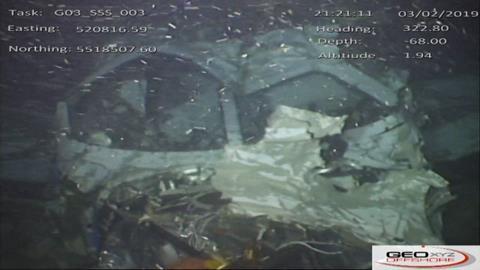UK accident investigators have concluded that the pilot of the doomed Piper Malibu PA-46-310P (N264DB) that crashed on 21 January 2019 in the sea off Guernsey carrying Argentinian footballer Emiliano Sala was not licensed to fly the aircraft at the time of the accident and was conducting an illegal charter.
David Ibbotson was also likely to have been suffering from the effects of carbon monoxide (CO) poisoning in the latter stages of the flight, which would have impaired his ability to control the aircraft.

In its final report into the incident, published on 13 March, the Air Accidents Investigation Branch (AAIB) determined that Ibbotson was flying on a US Federal Aviation Administration private pilot’s licence (PPL) - issued on the basis of his European Union Aviation Safety Agency (EASA) PPL - and was only qualified to fly in daylight hours under visual flight rules (VFR).
However, the single-engined pilot rating on his EASA licence - issued by the UK Civil Aviation Authority (CAA) - expired in November 2018, rendering Ibbotson unqualified to undertake the flight.
The AAIB also concludes that Ibbotson had been ”paid a fee for flights on numerous occasions”, and was to be paid for the “accident flight”, although as a PPL holder he was not qualified to carry passengers for hire and reward.
“The regulations under which the aircraft was operated and maintained permitted it to be used for private use only,” says the AAIB. It notes that no permission had been sought or granted which allowed the US-registered aircraft to be operated commercially.
“A higher level of regulatory burden applies to commercial, compared with private flights, such as more stringent medical, licensing and airworthiness requirements,” says the AAIB. A PPL holder flying a passenger for financial gain would be operating an illegal charter, it adds.
Ibbotson had no experience in commercial or night flying. He also lacked practice in instrument flying, says the AAIB.
“It is likely that pilot felt some pressure to complete the return leg of the flight, even though it would be at night and in poor weather,” it adds.
Ibbotson flew Sala in the 1984-built Malibu from Cardiff, Wales to Nantes, France on 19 January, with a return flight scheduled to depart two days later. The report notes that N264DB was equipped with an ice-protection system that allowed it to fly into known icing conditions. The six-seat aircraft was also fitted with avionics that allowed it to be flown safely at night in instrument meteorological conditions, however the autopilot and flight director had been diagnosed with an intermittent fault “and should have been placarded as inoperative”, says the AAIB.
Ibbotson’s planned route on 21 January would have taken the aircraft on an almost direct track from Nantes, flying over Guernsey, the report says. The VFR flightplan indicated a cruise altitude of 6,000ft and a distance of 265nm (490km).
The aircraft departed at 19:15 local, climbing to 5,500ft in line with the flightplan.

The forecast showed a cold front moving in from the northwest, with the possibility of isolated showers during the flight. At 20:02, and around 13nm south of Guernsey, Ibbotson requested a descent to remain in visual meteorological conditions.
Ibbotson then requested permission from air traffic control to fly at a lower level to maintain visibility.
He was cleared to fly at 5,000ft, and when asked if a further descent was required, Ibbotson responded: “Negative. Just avoided a patch there but back on heading 5,000ft.”
Once the aircraft had passed to the north of Guernsey, there would have been few lights visible from the surface vessels in the English Channel, says the report. “At an altitude at which the aircraft was flying, the horizon would have been visible between 80nm (150km) and 90nm away in perfect conditions, but there was rain and moisture in the atmosphere which would have obscured the horizon and reduced this distance significantly,” it adds.
The last radio communication received from the aircraft was at 20.12 when Ibbotson asked for, and was granted permission to, reduce altitude again. “A series of turns was flown over about 90sec probably so that the aircraft would remain in or regain VMC. During the turns, the flightpath was unstable and inconsistent with normal cruise flight, or with use of the autopilot,” says the report.
The aircraft’s last recorded secondary radar point was 20:16. Radar readings show the aircraft began a turn to the right, and descend. “As it descended through approximately 2,700ft above mean sea level, the angle of bank was approximately 90 degrees and the airspeed around 235kt [435km/h],” says the report.
AAIB describes the altitude and speed of the Piper as “far from typical values encountered in normal operations”. This indicates, it says, that the autopilot was not engaged and “control of the aircraft had been lost”.

Around 30s later, as the aircraft descended below 2,700ft, there was an abrupt nose-up pitch input when the airspeed was at least 100kt above the designed manoeuvring speed. “During the subsequent pull-up manoeuvre, aerodynamic loads exceeded design limits and caused the structural failure of the elevator and horizontal stabiliser, followed by the structural failure of both wings and splice joints,” says the report.
The final secondary radar contact with the aircraft was at 20:16:34. The aircraft struck the sea in an inverted, left wing low, nose-high attitude. “The impact with the sea was not survivable,” says the AAIB.
A loss of control was made more likely because the flight was not conducted “in accordance with safety standards applicable to commercial operations,” says the report. “This manifested itself in the flight being operated under VFR at night, in poor weather conditions despite the pilot having no training in night flying and a lack of recent practice in instrument flying.”
The Malibu was located on the seabed by sonar on 3 February, before a submersible with cameras dived at the site and was able to confirm it was the missing aircraft. Video footage from the AAIB shows the aircraft in three parts, with the wreckage held together by electrical and flying control cables, and the engine disconnected from the cockpit area.
Sala’s body was recovered from the wreckage on 6 February, but Ibbotson has not been located.
Toxicology tests on Sala’s body found he has been exposed to potentially lethal levels of carbon monoxide which may have also have incapacitated Ibbotson.
CO is a colourless, odourless gas that can be produced by combustion engines. “It readily combines with haemoglobin in the blood, decreasing the carriage of oxygen and causing a direct effect on the performance of those parts of the body which rely on oxygen for proper function,” says the AAIB.
The most likely reason for CO to have entered the aircraft, according to the report, “was a failure of the part of the exhaust tailpipe containing the heater muff, which allowed exhaust gas to mix the ram air and enter the cabin through the cabin conditioning system”.
The exhaust system, including the heater muff was visually inspected during the annual maintenance, 11 flying hours before the accident, the investigation shows. However, it adds that in-service inspections of exhaust systems do not eliminate the risk of CO poisoning.
The AAIB has issued a number of recommendations in relation to the accident. Firstly, that EASA, the FAA and the CAA require piston-engined aircraft which may have risk of CO poisoning to have a detector with an active warning fitted which will alert pilots to the presence of elevated levels of the gas.
It also recommends that the CAA has an effective system in place to maintain “accurate and up-to-date records related to personnel licences, certificates and ratings.”


























